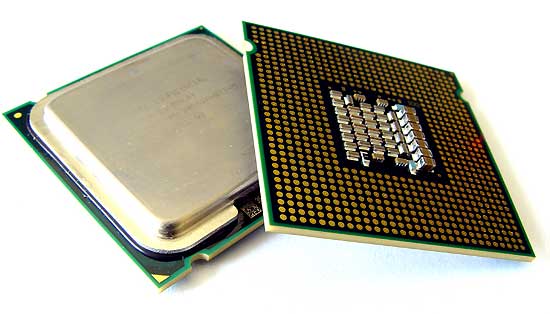Page 2
 Despite the fact that we are testing the performance of three Core 2 Duo processors today Intel has launched no less than five models in a variation of 1.6 to 2.67 GHz.
Despite the fact that we are testing the performance of three Core 2 Duo processors today Intel has launched no less than five models in a variation of 1.6 to 2.67 GHz.
The processors with model-numbers E6300 up-to E6700 make use of a 1066 MHz frontside bus. Both the E6600 and E6700 processors have an amazing 4 MB L2-cache on-board which makes them fly, the lower clocked Core 2 Duo's have 2MB L2 cache on-board. All these Core 2 Duo processors have a low TDP. The Thermal Design Power (TDP) (sometimes called Thermal Design Point) represents the maximum amount of power the thermal solution in a computer system is required to dissipate. For example, a laptop's CPU cooling solution may be designed for a 20 W TDP, which means that it can dissipate (either via an active cooling method such as a fan, a passive cooling method via natural convection, via heat radiation or all three modes of heat transfer) the heat generated by 20 watts without exceeding the maximum junction temperature for the part.
Obviously all processors have a 65 Watt TDP rating.
Followed by these five Core 2 Duo processors Intel released the Core 2 Extreme processor which you can find in the stores with model number X6800. This little gem is clocked at 2.93 GHz. This processor also has 4 MB L2-cache yet uses slightly more energy (TDP) at 95 Watt. Let's place this product segment into a table to get an overview
| Intel Core 2 Processors | ||||
|---|---|---|---|---|
| Frontside bus | Frequency | L2 cache | TDP | |
|
Intel Core 2 Extreme X6800 |
1066 MHz | 2.93 GHz | 4 MB | 95 W |
| Intel Core 2 Duo E6700 | 1066 MHz | 2.67 GHz | 4 MB | 65 W |
| Intel Core 2 Duo E6600 | 1066 MHz | 2.4 GHz | 4 MB | 65 W |
| Intel Core 2 Duo E6400 | 1066 MHz | 2.13 GHz | 2 MB | 65 W |
| Intel Core 2 Duo E6300 | 1066 MHz | 1.86 GHz | 2 MB | 65 W |
| Intel Core 2 Duo E4200 | 800 MHz | 1.6 GHz | 2 MB | 65 W |
Say bye-bye to NetBurst and the 90nm fabrication process. AMD has to seriously bite the dust here as the Conroe core based processors deliver heaps of performance for a far better price. The key differences of the new architecture from the "ideologically closest" Intel Core Duo (Yonah) are as follows:
- Improved instruction decoder extended to 4 decoders of x86 macroops (vs. 3 of Intel Pentium M / Core Duo)
- 128-bit SIMD instruction performance of 1 instruction per clock in each execution unit (twice as faster as Yonah)
- Improved memory operation and hardware prefetch mechanisms
- L2 cache is dynamically shared by both cores depending on load (as seen in Intel Core Duo)
- Further improved energy saving
- A new SIMD instruction set SSE4.
| CPU | Price |
| Intel Core 2 Extreme X6800 (2.93GHz/4M) | $999 |
| Intel Pentium Extreme Edition 965 (3.73GHz/2Mx2) | $999 |
| Intel Core 2 Duo E6700 (2.67GHz/4M) | $530 |
| Intel Core 2 Duo E6600 (2.40GHz/4M) | $316 |
| Intel Pentium D 960 (3.60GHz/2Mx2) | $316 |
| Intel Core 2 Duo E6400 (2.13GHz/2M) | $224 |
| Intel Pentium D 950 (3.40GHz/2Mx2) | $224 |
| Intel Core 2 Duo E6300 (1.86GHz/2M) | $183 |
| Intel Pentium D 940 (3.20GHz/2Mx2) | $183 |
| Intel Pentium D 930 (3.00GHz/2Mx2) | $178 |
| Intel Pentium D 920 (2.80GHz/2Mx2) | $178 |
| Intel Pentium D 820 (2.80GHz/1Mx2) | $133 |
| Intel Pentium D 805 (2.66GHz/1Mx2) | $93 |
The Core 2 processors pricing will be roughly as above. By doing this Intel has priced Core 2 Duo processors competitively with a traditional Pentium 4 processors on all price points. At the low end of the spectrum are the 2MB L2 cache equipped Core 2 Duo E6300 and E6400 priced at $183 and $224 respectively. For an extra few bucks consumers can pickup the fantastic price/performance wise Core 2 E6600 with 4MB of L2 cache.
Topping off the Core 2 Duo lineup is the E6700 for $530. And the flagship Core 2 Extreme X6800: 2.93 GHz will be priced at $999.
